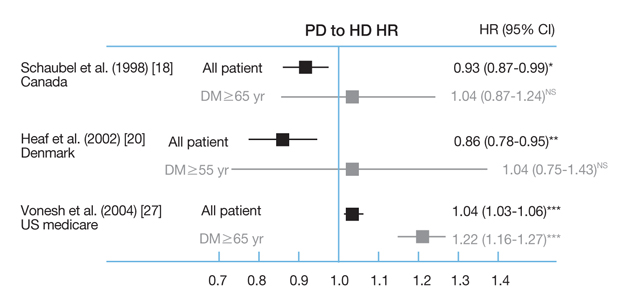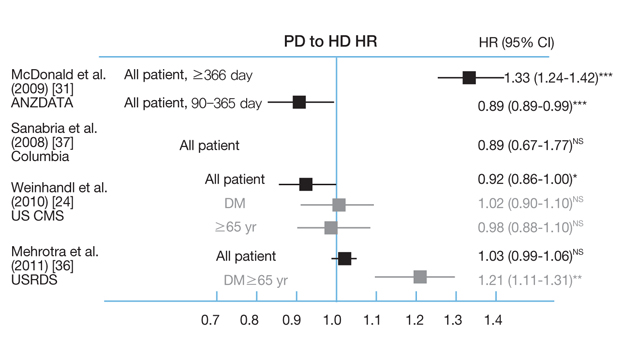J Korean Med Assoc.
2013 Jul;56(7):569-575. 10.5124/jkma.2013.56.7.569.
Clinical outcomes by dialysis modality in patients with end stage renal disease
- Affiliations
-
- 1Department of Internal Medicine, Kyungpook National University School of Medicine, Korea. ylkim@knu.ac.kr
- 2Clinical Research Center for End-stage Renal Disease, Daegu, Korea.
- KMID: 2193046
- DOI: http://doi.org/10.5124/jkma.2013.56.7.569
Abstract
- The prevalence of hemodialysis (HD) and peritoneal dialysis (PD) as a treatment modality for end-stage renal disease (ESRD) varies among countries and is affected by non-clinical factors including insurance, the health care system, and the preferences for treatment providers rather than clinical factors. There are pros and cons to both modalities. So far, since no randomized controlled trials have succeeded in revealing which dialysis modality is better, knowledge on clinical outcomes in patients with ESRD by dialysis modality is based on the results from multicenter prospective observational studies and large-scale national registry data in each country. In prospective cohort studies in the 1990's, HD showed similar or higher mortality than PD during the first year, but PD showed higher mortality after the first year. Meanwhile, clinical outcomes of dialysis patients resulting from national registry data in the 1990's were similar for PD and HD. From national registry data after 2000, the survival of patients on both HD and PD improved rapidly. This improvement was much greater in PD, especially in the early period after initiation of dialysis. Non-diabetic patients less than 65 years old showed better outcomes with PD than HD, whereas diabetic patients aged more than 65 years old (especially females) showed better outcomes with HD than PD. A higher risk of death in diabetic PD patients, though still present in the most recent cohorts, has been progressively attenuated over time in recent cohorts.
Keyword
MeSH Terms
Figure
Reference
-
1. Lameire N, Van Biesen W. Epidemiology of peritoneal dialysis: a story of believers and nonbelievers. Nat Rev Nephrol. 2010; 6:75–82.
Article2. Jin DC. Current status of dialysis therapy in Korea. Korean J Intern Med. 2011; 26:123–131.
Article3. Lilly MP, Lynch JR, Wish JB, Huff ED, Chen SC, Armistead NC, McClellan WM. Prevalence of arteriovenous fistulas in incident hemodialysis patients: correlation with patient factors that may be associated with maturation failure. Am J Kidney Dis. 2012; 59:541–549.
Article4. Sonawane S, Kasbekar N, Berns JS. The safety of heparins in end-stage renal disease. Semin Dial. 2006; 19:305–310.5. Cameron JI, Whiteside C, Katz J, Devins GM. Differences in quality of life across renal replacement therapies: a meta-analytic comparison. Am J Kidney Dis. 2000; 35:629–637.
Article6. Schaefer F, Warady BA. Peritoneal dialysis in children with end-stage renal disease. Nat Rev Nephrol. 2011; 7:659–668.
Article7. Oreopoulos DG. The optimization of continuous ambulatory peritoneal dialysis. Kidney Int. 1999; 55:1131–1149.
Article8. Foley RN, Gilbertson DT, Murray T, Collins AJ. Long interdialytic interval and mortality among patients receiving hemodialysis. N Engl J Med. 2011; 365:1099–1107.
Article9. Perl J, Wald R, Na Y, Bell CM, Harel Z. Continuous mortality risk among peritoneal dialysis patients. Arch Intern Med. 2012; 172:589–590.
Article10. Kim YL, Cho JH, Choi JY, Kim CD, Park SH. Systemic and local impact of glucose and glucose degradation products in peritoneal dialysis solution. J Ren Nutr. 2013; 23:218–222.
Article11. Korevaar JC, Feith GW, Dekker FW, van Manen JG, Boeschoten EW, Bossuyt PM, Krediet RT. NECOSAD Study Group. Effect of starting with hemodialysis compared with peritoneal dialysis in patients new on dialysis treatment: a randomized controlled trial. Kidney Int. 2003; 64:2222–2228.
Article12. ClinicalTrials.gov. Comparison of the impact of dialysis treat-ment type on patient survival [Internet]. Bethesda: Clinical-Trials.gov;2008. cited 2013 Jun 13. Available from: http://www.clinicaltrials.gov/ct2/show/NCT00510549?term=NCT00510549&rank=1.13. Chiu YW, Jiwakanon S, Lukowsky L, Duong U, Kalantar-Zadeh K, Mehrotra R. An update on the comparisons of mortality outcomes of hemodialysis and peritoneal dialysis patients. Semin Nephrol. 2011; 31:152–158.
Article14. Jaar BG, Coresh J, Plantinga LC, Fink NE, Klag MJ, Levey AS, Levin NW, Sadler JH, Kliger A, Powe NR. Comparing the risk for death with peritoneal dialysis and hemodialysis in a national cohort of patients with chronic kidney disease. Ann Intern Med. 2005; 143:174–183.
Article15. Termorshuizen F, Korevaar JC, Dekker FW, Van Manen JG, Boeschoten EW, Krediet RT. Netherlands Cooperative Study on the Adequacy of Dialysis Study Group. Hemodialysis and peritoneal dialysis: comparison of adjusted mortality rates according to the duration of dialysis: analysis of The Netherlands Cooperative Study on the Adequacy of Dialysis 2. J Am Soc Nephrol. 2003; 14:2851–2860.
Article16. Foley RN. Comparing the incomparable: hemodialysis versus peritoneal dialysis in observational studies. Perit Dial Int. 2004; 24:217–221.
Article17. Collins AJ, Hao W, Xia H, Ebben JP, Everson SE, Constantini EG, Ma JZ. Mortality risks of peritoneal dialysis and hemodialysis. Am J Kidney Dis. 1999; 34:1065–1074.
Article18. Schaubel DE, Morrison HI, Fenton SS. Comparing mortality rates on CAPD/CCPD and hemodialysis: the Canadian experience: fact or fiction? Perit Dial Int. 1998; 18:478–484.
Article19. Liem YS, Wong JB, Hunink MG, de Charro FT, Winkelmayer WC. Comparison of hemodialysis and peritoneal dialysis survival in The Netherlands. Kidney Int. 2007; 71:153–158.
Article20. Heaf JG, Lokkegaard H, Madsen M. Initial survival advantage of peritoneal dialysis relative to haemodialysis. Nephrol Dial Transplant. 2002; 17:112–117.
Article21. Selgas R, Cirugeda A, Fernandez-Perpen A, Sanchez-Tomero JA, Barril G, Alvarez V, Bajo MA. Comparisons of hemodialysis and CAPD in patients over 65 years of age: a meta-analysis. Int Urol Nephrol. 2001; 33:259–264.22. Van Laecke S, Veys N, Verbeke F, Vanholder R, Van Biesen W. The fate of older diabetic patients on peritoneal dialysis: myths and mysteries and suggestions for further research. Perit Dial Int. 2007; 27:611–618.
Article23. Winchester JF, Harbord N, Audia P, Dubrow A, Gruber S, Feinfeld D, Amerling R. The 2006 K/DOQI guidelines for peritoneal dialysis adequacy are not adequate. Blood Purif. 2007; 25:103–105.
Article24. Weinhandl ED, Foley RN, Gilbertson DT, Arneson TJ, Snyder JJ, Collins AJ. Propensity-matched mortality comparison of incident hemodialysis and peritoneal dialysis patients. J Am Soc Nephrol. 2010; 21:499–506.
Article25. Carrero JJ, de Jager DJ, Verduijn M, Ravani P, De Meester J, Heaf JG, Finne P, Hoitsma AJ, Pascual J, Jarraya F, Reisaeter AV, Collart F, Dekker FW, Jager KJ. Cardiovascular and noncardiovascular mortality among men and women starting dialysis. Clin J Am Soc Nephrol. 2011; 6:1722–1730.
Article26. Carrero JJ, de Mutsert R, Axelsson J, Dekkers OM, Jager KJ, Boeschoten EW, Krediet RT, Dekker FW. NECOSAD Study Group. Sex differences in the impact of diabetes on mortality in chronic dialysis patients. Nephrol Dial Transplant. 2011; 26:270–276.
Article27. Vonesh EF, Snyder JJ, Foley RN, Collins AJ. The differential impact of risk factors on mortality in hemodialysis and peritoneal dialysis. Kidney Int. 2004; 66:2389–2401.
Article28. Basu R, Dalla Man C, Campioni M, Basu A, Klee G, Toffolo G, Cobelli C, Rizza RA. Effects of age and sex on postprandial glucose metabolism: differences in glucose turnover, insulin secretion, insulin action, and hepatic insulin extraction. Diabetes. 2006; 55:2001–2014.29. Cavalot F, Petrelli A, Traversa M, Bonomo K, Fiora E, Conti M, Anfossi G, Costa G, Trovati M. Postprandial blood glucose is a stronger predictor of cardiovascular events than fasting blood glucose in type 2 diabetes mellitus, particularly in women: lessons from the San Luigi Gonzaga Diabetes Study. J Clin Endocrinol Metab. 2006; 91:813–819.
Article30. Collins AJ, Foley RN, Gilbertson DT, Chen SC. The state of chronic kidney disease, ESRD, and morbidity and mortality in the first year of dialysis. Clin J Am Soc Nephrol. 2009; 4:Suppl 1. S5–S11.
Article31. McDonald SP, Marshall MR, Johnson DW, Polkinghorne KR. Relationship between dialysis modality and mortality. J Am Soc Nephrol. 2009; 20:155–163.
Article32. Mehrotra R, Kermah D, Fried L, Kalantar-Zadeh K, Khawar O, Norris K, Nissenson A. Chronic peritoneal dialysis in the United States: declining utilization despite improving outcomes. J Am Soc Nephrol. 2007; 18:2781–2788.
Article33. US Renal Data System. USRDS 2005 annual data report: atlas of end-stage renal disease in the United States. New York: Grune & Stratton;2006.34. Wolfe RA, Ashby VB, Milford EL, Ojo AO, Ettenger RE, Agodoa LY, Held PJ, Port FK. Comparison of mortality in all patients on dialysis, patients on dialysis awaiting transplantation, and recipients of a first cadaveric transplant. N Engl J Med. 1999; 341:1725–1730.
Article35. Korean Network for Organ Sharing (KONOS). Associated organization [Internet]. 2010. Seoul: Korean Network for Organ Sharing;Available from: http://www.konos.go.kr/konosis/common/bizlogic.jsp.36. Mehrotra R, Chiu YW, Kalantar-Zadeh K, Bargman J, Vonesh E. Similar outcomes with hemodialysis and peritoneal dialysis in patients with end-stage renal disease. Arch Intern Med. 2011; 171:110–118.
Article37. Sanabria M, Munoz J, Trillos C, Hernandez G, Latorre C, Diaz CS, Murad S, Rodriguez K, Rivera A, Amador A, Ardila F, Caicedo A, Camargo D, Diaz A, Gonzalez J, Leguizamon H, Lopera P, Marin L, Nieto I, Vargas E. Dialysis outcomes in Colombia (DOC) study: a comparison of patient survival on peritoneal dialysis vs hemodialysis in Colombia. Kidney Int Suppl. 2008; (108):S165–S172.
Article38. Suzuki K, Konta T, Ichikawa K, Ikeda A, Niino H, Hoshikawa M, Takahashi T, Abiko H, Ito M, Masakane I, Matsunaga T, Kudo K, Sato H, Degawa N, Kubota I. Comparison of mortality between Japanese peritoneal dialysis and hemodialysis patients: a 5-year multicenter follow-up study. Int J Nephrol. 2012; 2012:231018.
Article39. Strippoli GF, Tong A, Johnson D, Schena FP, Craig JC. Catheter-related interventions to prevent peritonitis in peritoneal dialysis: a systematic review of randomized, controlled trials. J Am Soc Nephrol. 2004; 15:2735–2746.
Article40. Huisman RM, Nieuwenhuizen MG, Th de Charro F. Patient-related and centre-related factors influencing technique survival of peritoneal dialysis in The Netherlands. Nephrol Dial Transplant. 2002; 17:1655–1660.
Article41. Choi JY, Jang HM, Park SH, Kim CD, Kim SH, Do JY, Kim SE, Song SH, Kim YH, Lee JS, Kim YS, Kang SW, Yang CW, Kim NH, Kim YL. Comparison of outcomes between dialysis modalities in ESRD patients: 2 year follow-up report [abstract]. Proceedings of the 32th Spring Conference of Korean Society of Nephrology. 2012 May 18-20; Seoul, Korea. Seoul: Korean Society of Nephrology;–104.
- Full Text Links
- Actions
-
Cited
- CITED
-
- Close
- Share
- Similar articles
-
- New dialysis treatment options for patients with end-stage chronic kidney disease
- Peritoneal dialysis in children and adolescents
- Dialysis in a Patient with Hemophilia
- Acquired Cystic Kidney Disease in Patients Undergoing Long-term Hemodialysis Treatment
- Risk factors for peptic ulcer disease in patients with end-stage renal disease receiving dialysis



